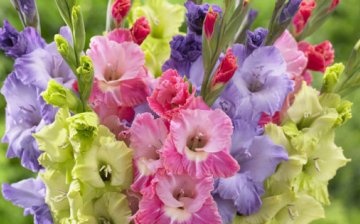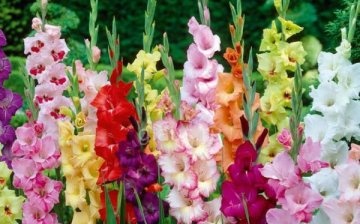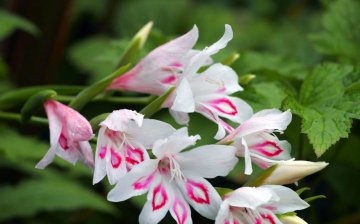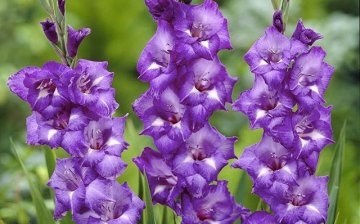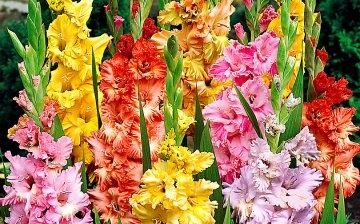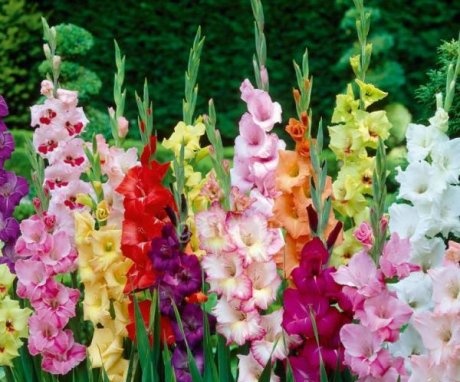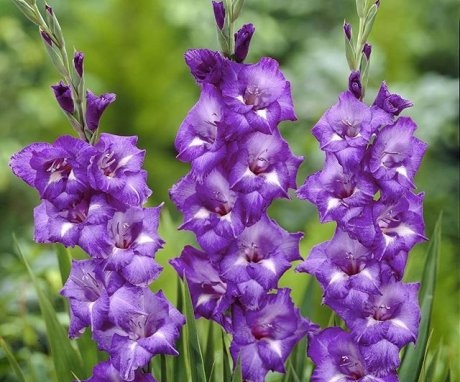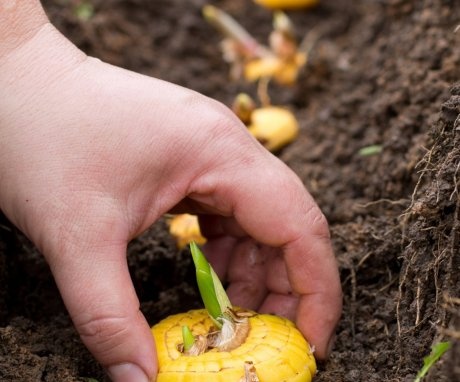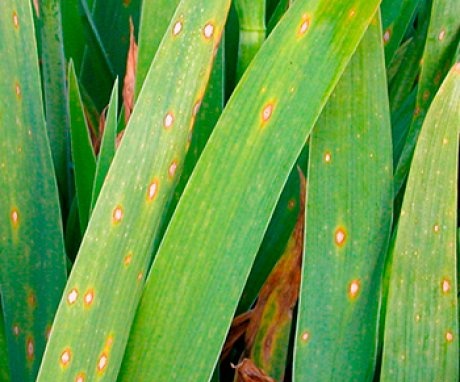Interesting varieties of gladioli for the garden: description and cultivation
Gladioli - this is a marvelous decoration of flower beds, flower beds and small lawns adjacent to the house. Usually flowers are grown either separately, alone, or planted in flowerpots along with undersized or creeping greenery. However, gardeners often complain about the difficulty of growing flowers.
Often, plants begin to bloom unevenly or turn yellow and dry out for unknown reasons. To avoid bad experience, you need to choose the right site for the plant, provide it with all the conditions for normal growth and properly care for it. The correct choice of the gladiolus variety is also important. All these nuances will be discussed in the gardener's notes.
Content:
- Types of gladioli and their best varieties
- Growing conditions - choose a place
- Preparing and planting bulbs
- Gladioli care
- Diseases and pests
Types of gladioli and their best varieties
Growing gladioli as a decoration for gardens and parks, it was widespread in ancient Rome. The beauty of these plants was appreciated and various magical properties were attributed to them. Gladiolus is overgrown with legends that have survived to this day. However, in the old days, only a few plant species were distinguished.
Today, breeders have bred a great variety of varieties and hybrids.
Understanding such a variety is not easy. Therefore, gladioli are usually classified according to types, ripening periods and forms. The varieties you need to select are those that were bred specifically for your region. Otherwise, it will be possible to enjoy the lush flowering at best once. There are five main categories of gladioli:
- Tartar (bloom in early summer)
- Common (bloom in summer)
- Kochi (bloom in spring, low plants are used to decorate ridges and mixborders)
- Byzantine (bloom all summer)
- Swamp (plants of this type can be grown in lowlands, on swampy soils)
It is customary to grow ordinary gladiolus in the gardens. There are a huge number of hybrids of this species, which amaze with their color palette and shapes. The classification of varieties is based on the timing of flowering. It is very convenient. You can pick up such gladioli that will delight all summer. The more common color classification is based on the size of the plant's inflorescences. There are three large groups of gladioli:
- Large-flowered gladioli. The best varieties and hybrids in this category include Don Quixote, Oscar, Minerva, Canada, Velvet, Manser and Peacock Eye.
- Medium-flowered plants. In this group, such varieties and hybrids as "Elegy", "Ilse", "Mayuba", "Polaris", "Albit" and "America" deserve special attention.
- Small-flowered gladioli. The best varieties and hybrids in this category include "Focus" and "Leviathan".
Particular attention should be paid to the dwarf species of gladiolus. Such plants can be planted in mixborders or along paths. They also look spectacular in the first row of flower beds. The best varieties of this type include
- "Nymph" - on a white background of petals, pale pink strokes flaunt
- "Cinderella - red patterns on a pink background
- Spitfire - dark background with yellow spots
- "Bow Peep" - apricot shade of petals
It is also worth highlighting the butterfly-shaped gladioli. Their inflorescences resemble the open wings of butterflies. Florists prefer to grow:
- "Alice" - orange-colored spots on a pink background
- "Georgette" - yellow strokes on a red background
- "Tinkerbell" - a sunny shade
You can endlessly talk about the varieties of gladioli. After all, their number is huge, thousands of hybrids. Therefore, when choosing a gladiolus for a site, try to be guided not only by the appearance, but also by the regional belonging of the plant. So, don't grow Dutch flowers in Siberia. Nothing will come of it. In the best case, the plant will bloom, but this is where its "life" ends. That is, instead of 3-4 years of growth, it will delight the gardener only once. If you plan to grow a plant in a greenhouse or greenhouse, then you can afford to choose collectible varieties.
Growing conditions - choose a place
For gladioli it is very important to choose a good location. Almost all species have one common feature - the plant does not tolerate shade and dampness. Only marsh gladiolus species can grow successfully in partial shade and moist soil. The rest will bloom and develop only in a sunny area in well-drained soil.
It is desirable that the place for gladioli has a slight slope to the south. This is necessary for the outflow of excess water in the event of heavy and prolonged rains. As for the soil, it can be sandy loam soil and ordinary garden soil. Heavy, clayey soil is diluted with sand, humus and compost.
The main requirement for the earth is air and moisture permeability.
It should also have a slightly acidic environment. If the soil is acidic, the plant will turn yellow, bloom may not come. Therefore, such soil must be mixed with dolomite flour or chalk. It is also important to take into account the proximity of groundwater. For growing gladioli, their close occurrence to the surface is unacceptable.
The site must be protected from drafts and strong winds. This condition is especially important for large-flowered species, the height of which reaches 1-1.5 m. For dwarf flowers, it can be disregarded. The best precursors for planting are legumes, garlic, or vegetables other than root vegetables. The correct selection of the site is the key to a healthy and lush bloom of gladioli. The second stage will be the competent preparation of the bulbs and their planting.
Preparing and planting bulbs
If the bulbs were purchased from a garden center, they do not need preparation. The grower always processes the seed. If the bulbs were taken from a neighbor or bought in a dubious place, where there is not even a quarantine certificate for seed, preparation is needed. This should be done a month before planting.
First of all, the bulbs are examined for brown or black spots - the affected specimens are discarded.
The seed must be firm, not flabby. The dense upper scales are removed. If there are small areas affected by sclerotinia or scab, they can be carefully cut with a knife. Treat the cut points with brilliant green. For disinfection, the bulbs are immersed in a foundationol solution for an hour. Then they are washed and left to dry. If there is no desire to disinfect the seed, immerse it for half an hour in a solution of potassium permanganate before planting.
Landing features:
- The site for gladioli is prepared in the fall. The earth is dug up and brought in organic and mineral fertilizers.
- In the spring, it is enough to harrow the site and prepare shallow trenches for planting.
- Large bulbs are buried by 10-12 cm, small ones by 8-10 cm.The distance between the bulbs is 10-15 cm, between the ridges a maximum of 25 cm.
- Lay a layer of sand or peat at the bottom of the trench. So the bulbs will not be affected by fungal diseases or rot.
- Sprinkle them with earth on top. It is important to plant gladioli in warm ground, the temperature of which should be at least 10 °.This is usually the end of April or the beginning of May, depending on the region.
With proper preparation and planting of the bulbs, gladioli will successfully sprout and grow. In order for them to bloom magnificently, it is necessary to provide proper care.
Gladioli care
The care of gladioli includes standard procedures:
- Pay special attention to making fertilizers... The splendor of the flowering and the health of the plant will depend on this. The first fertilizing with nitrogen content is applied when there are already three true leaves on the sprout. The second is introduced during the formation of six leaves - nitrogen, phosphorus and potassium. The third is intended for the budding period. It should include mainly phosphorus-potassium fertilizers. As a result, during the growing season, fertilizers are applied three times. Too frequent feeding is undesirable. Gladioli will begin to fatten, flowering will not come.
- The plant loves moisture very much. Therefore, during the growing season, lay a layer mulch from humus. It will retain moisture and saturate gladiolus with useful elements. If it rains frequently, loosen the soil. A crust must not be allowed to form. Gladiolus needs air.
- Timely weeding is also important. Otherwise, the weeds will drown out the flower. Too high stems must be tied to pegs. Remove faded inflorescences.
- In the fall, the bulbs are dug up and prepared for winter. The inoculum must be sorted out and diseased specimens discarded. The bulbs are dried and placed in a cool room - basement or cellar. The storage temperature should not exceed 10 °.
Proper care is a guarantee of lush flowering and plant health.
Diseases and pests
The most common diseases of gladioli are fusarium, cancer, scab, gray rot and mosaic. Ailments can affect the plant if the weather is cool all summer and it rains constantly. In these conditions, diseases appear. It is very difficult to save a flower bed from fungal and viral ailments. Experienced growers recommend removing plants and treating the soil after them. fungicides.
Prevention has always been considered the most reliable way to fight disease. To prevent the onset of ailments, follow one simple rule - crop rotation... Gladioli can be planted in the same place only twice. Do not plant the plant after potatoes or tomato... Observe all growing conditions and properly care for flowers.
Always treat the bulbs before planting with a solution of foundazol or potassium permanganate - this way the risk of disease will be minimized.
Of the pests, thrips and wireworms... The former are disposed of with the help of insecticides. If a wireworm has eaten the bulbs, treat them with a fungicide. During the entire growing season, spray the plants with insecticides three times. Thrips will not appear this way.
Growing gladioli in the garden is not that difficult. However, be sure to follow the rules for planting, caring for and storing bulbs in winter. In this case, the gardener will only have to admire the magnificent beauty of the majestic gladiolus!
More information can be found in the video:



